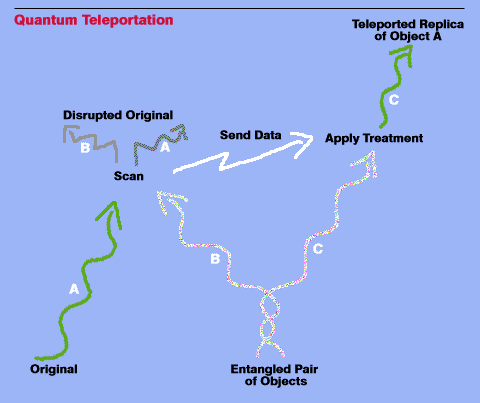Search
Science and Science Fiction: What Exactly Is Teleportation?
April 7th, 2008
A comment on my Standing on the Ledge with Jumper post got me thinking about this issue today. I realized that to a great degree my disagreement with others concerns the definition of teleportation, and how I think that the standard has slipped for PR purposes.
I think at one extreme every can agree on what constitutes teleportation. An object in one location instantaneously moves from one spatial coordinate to another, without being in the space between those coordinates. This pure definition rules out a lot of phenomena that might look like teleportation, and might be too strict for some, but is close to what I think is appropriate. I’ll explain in this post, and explore some other possible definitions and applications that might fit within those.
First, let’s have a little discussion about the often overlooked science issues involved with this classical teleportation. Larry Niven wrote a great essay called the Theory and Practice of Teleportation that is well worth a read. (Sorry, the link wasn’t working properly just now, and I’ve linked to the cached version.) Some of the issues discussed involve energy conservation principles in physics. For instance, how are potential energy and relative velocity treated with respect to a teleporter? There’s a lot to consider there, so please read Niven if you haven’t.
There’s one part from the essay that got me though:
DEFINITION:
Teleportation is any method of moving from point to point in negligible time. Over short distances we will take lightspeed as negligible. Over longer distances (interplanetary and interstellar) we will require infinite or near-infinite speed.
I make a distinction between psychic and mechanical teleportation. Essentially, psi teleportation involves wishing oneself from place to place. In mechanical teleportation he pushes a button. He may do other things first, such as sighting in, charging batteries, weighing and measuring his cargo, whatever it takes. But eventually he will push a button here and he will instantly be there. Similarly, the adept at psi teleportation may have spent decades in spiritual training, learning to negate distance by the power of a wish.
These definitions are not meant to be rigorous. Intuitively you know what teleportation is anyway.
Do we? First, discounting “psi teleportation” which is a literary device and marks a story primarily as fantasy (or science fantasy, but lets avoid defining sub-genres), I’ve discovered that those pushing “quantum teleportation” have their own definition that differs from Niven’s.
Here is a nice informative webpage about quantum teleportation that begins with: “Teleportation is the name given by science fiction writers to the feat of making an object or person disintegrate in one place while a perfect replica appears somewhere else.”
Hmm. That sounds a little different. We’re suddenly talking about disintegration and perfect replicas. This distinction is important because it is a slippery slope. The time aspect is gone, and the focus is on replication, not transportation.
Replication is NOT teleportation. It could be part of a teleportation mechanism, but it isn’t an intrinsic part of a definition. Let me demonstrate.
Imagine a Star Trek replicator. It presumably operates by having scanned (destructively or not — this in a second) some object or food. Then the operator has the ability to recreate that object, perfectly (I assume), over and over again. After the first replication, is every perfect replica a teleportation? Of course not.
And from this perspective, why is “disintegration” part of the definition? Non-destructive scanning could be part of a perfect replication, in theory. On the receiving end, does it matter if the original is disintegrated? Only if you want to artificially create a difference between teleporting and copying. The quantum teleportation people are trying to do this, disingenuously, in my opinion.
Consider Jim Kelly’s story “Think Like a Dinosaur.” In it, humans are transported to far parts of the galaxy via an alien replicator. It doesn’t disintegrate them on this end. It’s up to a human operator to “balance the equations” and do this. A human facsimile is recreated on a faraway world, and it doesn’t matter on that end whether the original has been disintegrated. It matters to the dinosaurs, and it matters, artificially, to those wanting to claim that it’s teleportation in one case but not the other.
They also slip in “perfect” to describe the replica. This is trying to do two things. First, to distinguish quantum teleportation from a fax machine, which no one would call teleportation, and to play up a strength of the quantum entanglement which preserves states perfectly. Personally, I’d still consider myself teleported if the process wasn’t perfect and had some strange side effect, like losing all my hair or giving me a suntan. I reject the “perfect” part of the definition. And in any event, we are not the same from moment to moment anyway. Every instant the quantum states of the particles making up my body are changing. I’m not at all sure teleportation, in a bastard definition that involves copying, must be perfect.
So what about Star Trek, now that I’ve brought it up? They already have their consistency issues — sometimes a pattern saved in a buffer can be used and sometimes not — I don’t understand why anyone ever dies on that show. Make another copy from the last saved pattern after any death.
Anyway, I digress. The telling point on Star Trek for me is that their system, which scans people and moves them around and can even recreate them from a pattern (sometimes), isn’t called a teleporter beam. It’s a transporter beam. Quite rightly.
Let’s consider some different scenarios/technology and decide if they’re teleportation or not. How about if we turned people into light in one place and reconstructed them from that light in another (which I once saw in a Piers Anthony novel I’ve forgotten the name of)? Not teleportation. Travel time would seem instantaneous to the traveler, but that beam travels at a finite speed, can be intercepted, and so forth. I’d call it beaming at lightspeed, not teleportation myself.
How about instantaneous transmission of information? Not teleportation, since objects are not moved. At best that information can be used to make a copy. And this is the part of quantum teleportation that I usually discuss since something is happening instantaneously when a wave function collapses in a spatially separated and entangled system. It’s weird and “spooky action at a distance” as Einstein called it. The copying part of the process is to me replication, not teleportation.
There’s another few physical effects that may be equated with teleportation, more so than what is called quantum teleportation anyway:
Quantum tunneling. Particles have a chance to jump through barriers that are classically impossible to jump through. We usually talk about potential barriers and such rather than physical walls, but it’s really the same thing. Why didn’t quantum tunneling get labeled quantum teleportation? I don’t know. It’s more apt in some ways.
Hawking radiation. This is similar. In the vicinity of the event horizon of a black hole, some weird shit goes down. Hawking combined relativity and quantum mechanics to come up with a unique phenomenon. In the vacuum of space, particle and anti-particle can appear spontaneously, recombine, and vanish before they’re noticed. If that happens next to an event horizon, and one particle falls beyond the horizon, the other one must persist and be “emitted” as “radiation” from the black hole. Another way to look at the situation is that a particle teleported through the event horizon. OK, maybe that’s a stretch, but compare it to copying as teleportation.
Wormholes. Relativity in theory allows one piece of space to be connected to another in a strange way, so that while there are many paths with a finite distance, there’s also a special path with no distance, between the two points. Moving through this path, this wormhole, can in principle get you someplace instantaneously fast. Seems like teleportation to me, albeit limited to certain locations.
So let’s look again at quantum teleportation does. From the linked article above:
To make the teleportation work, you have to actually move the particles yourself! All that’s really being done is that some destructive scanning is being done, and the original particle is “perfectly replicated” in some location you’ve moved an entangled particle to.
Aside from the fact that this scheme doesn’t seem scalable up to actual macroscopic objects, let me push an imperfect but illustrative metaphor. Quantum teleportation is like a perfect fax machine, in which not only data are sent, but the magic template to put the data into as well, to make the faxing perfect. Would you call it teleportation if you shredded the paper your document was written on, then took two magic pieces of paper, waved one over the ashes of the original, and sent the other to a different location, and then could magically transform the second piece of paper into a perfect copy of the original?
Neat trick, but I wouldn’t call it teleportation.
You can follow any responses to this entry through the RSS 2.0 feed. You can leave a response, or trackback from your own site.



Maybo you can teleport yourself – only with the power of your mind? Think about it!